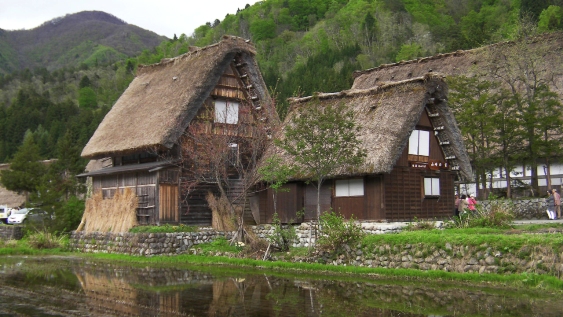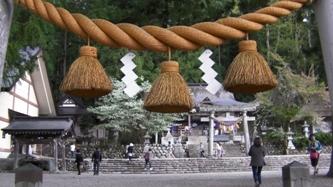
The houses vary in age but many of the basic wooden structures are over 200 years old.
The houses of Shirakawa-go are an impressive sight. The first thing you notice is naturally the massive, steeply sloping thatched roofs, built in the gassho-zukuri or praying hands style to shed Gifu’s heavy Winter snows, but once inside, you really appreciate how skillfully and organically the structures are designed and put together (traditionally without nails in the roof). Usually three or four stories high, they were originally built to house several generations of an extended family on the lower floors, with the upper levels used for cultivating silkworms and other “cottage” industries.
While other areas in Japan use similar building techniques, the houses in Shirakawa-go and nearby Gokayama are unique for their size, number and age – many are between 200 and 300 years old – and in 1995, both villages were registered as UNESCO World Heritage Sites. I’d been wanting to visit for many years after seeing magical photos of them blanketed in Winter snows so on a recent trip to Takayama, I made sure to jump a bus for the 50 minute journey to Shirakawa.
I first started to sense things might not be quite as expected when the bus hit a traffic jam. Fifty minutes stretched into over an hour, then an hour and a half and finally two hours before the bus crawled into the Shirakawa-go parking area. I was probably naive to expect otherwise but somehow the village’s live feed hadn’t shown all the tourists swarming around the houses, many of which have actually been turned into cafes, souvenir shops and accommodations.

Shirakawa-go’s heavily weather-seasoned temple
Fortunately, the buildings themselves live up to their billing, likewise the stunning snow-capped backdrop of the Japan Alps, and as long as you head outside the central area, there is still a large dose of that photo-magic to be had. All in all it was good experience but it’s worth knowing what’s coming your way if you plan on making the trip. For the record, I’ve since heard that although Gokayama is smaller and further from Takayama, it is less touristed and maintains more of its traditional atmosphere.
The journey back to Takayama gave me plenty of time to ponder the value of the World Heritage system. Its cultural and economic benefits are clear but while it does preserve historical sites, in this case, it also seems to turn them into virtual theme parks, devoid of the functionality that made them unique. It’s an idea Alex Kerr looks at in depth in his books “Lost Japan” and “Dogs and Demons” and one I find myself considering more and more often in my travels around Japan.
Obviously, it’s not just here. I was recently surprised to see how many tours there now are to Angkor Wat in Cambodia. Maybe it’s not a fair comparison: I was there in 1992 near the end of the civil war so visitors were in short supply. The temples were littered with bullet casings and you could still hear gunfire from the jungle as the air cooled down for the evening. A totally unforgettable experience! (Thanks for keeping me alive, CH.) Either way, I’m not sure “World Heritage Site” is going to be a sales point for me anymore.
Note: I’ve since been assured Angkor Wat remains a “magical place.” If you are thinking of visiting, please check out the Karavansara Retreat and Residences, a gorgeous boutique accommodation in Siam Riep. The owner, Joshua Levine, also operates the equally impressive Karavansara Kyoto Gosho Machiya, a fully restored traditional town house located right in the center of Kyoto near the Imperial Park.
Other details and resources
English section of Shirakawa-go Village Web site
Home page for Karavansara Retreat and Residences and Kyoto Gosho Machiya
More images and information available on Facebook (must be logged in)
